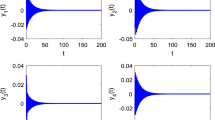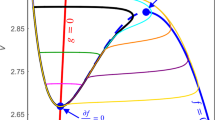Abstract
Phase coding in a neural network composed of neural oscillators with inhibitory neurons was studied based on the theory of stochastic phase dynamics. We found that with increasing the coupling coefficients of inhibitory neural oscillators, the firing density in excitatory population transits to a critical state. In this case, when we increase the inhibitory coupling, the firing density will come into dynamic balance again and tend to a fixed value gradually. According to the phenomenon, in the paper we found parameter regions to exhibit those different population states, called dividing zones including flat fading zone, rapid fading zone and critical zone. Based on the dividing zones we can choose the number ratio between inhibitory neurons and excitatory neurons in the neural network, and estimate the coupling action of inhibitory population and excitatory population. Our research also shows that the balance value, enabling the firing density to reach the dynamic balance, does not depend on initial conditions. In addition, the critical value in critical state is only related to the number ratio between inhibitory neurons and excitatory neurons, but is independent of inhibitory coupling and excitatory coupling.







Similar content being viewed by others
References
Haken H (1980) Synopsis and introduction, in synergetics of the brain. Springer, Berlin
Haken H (1996) Principle of brain functioning, a synergetic approach to brain activity, behavior and cognition. Springer, Berlin
Jiao X, Wang R (2009) synchronous firing patterns of neuronal population with excitory and inhibitory connections. To appear International Journal of Nonlinear Mechanics
Liu Y, Wang R, Zhang Z, Jiao X (2009) Analysis of neurodynamics on phase neural coding in the presence of inhibitory neurons, the 5th international conference on natural computation (ICNC’09)
Neiman AB, Russell DF, DiLullo A, Tass PA (2007) Response clustering in transient stochastic synchronization and desynchronization of coupled neuronal bursters. Phys Rev E 76:021908
Tass PA (1999) Phase resetting in medicine and biology. Springer, Berlin
Tass PA, Fieseler T, Dammers J, Dolan K, Morosan P, Majtanik M, Boers F, Muren A, Zilles K, Fink GR (2003) Synchronization tomography: a method for three-dimensional localization of phase synchronized neuronal populations in the human brain using magnetoencephalography. Phys Rev Lett 90:088101
Wagatsuma H, Yamaguchi Y (2005) Disambiguation of multiple sequence learning by theta phase coding. Brain Neural Netw 12:17–31
Wang R, Jiao X (2006) A stochastic nonlinear evolution model and neural coding on neuronal population possessing variable coupling intensity in spontaneous behavior. Neurocomputing 69(7–9):778–785
Wang R, Zhang Z (2003) Nonlinear stochastic models of neurons activities. Neurocomputing 51:401–411
Wang R, Zhang Z (2006) Mechanism on brain information processing: energy coding. Appl Phys Lett 89:123903
Wang R, Zhang Z (2007) Energy coding in biological neural network. Cogn Neurodyn 1(3):203–212
Wang R, Zhang Z (2009) Energy coding and energy functions for local activities of the brain. (accepted) Neurocomputing
Wang R, Zhang Z, Yu J (2006) A neural model on cognitive process. Lect Notes Comput Sci 3971:50–59
Wang R, Zhang Z, Chen G (2008) Energy function and energy evolution on neuronal populations. IEEE Trans Neural Netw 19(3):535–538
Winfree AT (1970) An integrated view of the resetting of circadian clock. Theor Biol 28:327–374
Winfree AT (1980) The geometry of biological time. Springer, Berlin
Yamaguchi Y, Aota Y, Sato N, Wagatsuma H, Wu Z (2004) Synchronization of neural oscillations as a possible mechanism underlying episodic memory: a study of theta rhythm in the hippocampus. J Integr Neurosci 3(2):143–157
Acknowledgments
The work was supported by the National Natural Science Foundation of China (NSFC) under Grant No.10872068 and No.10672057.
Author information
Authors and Affiliations
Corresponding author
Rights and permissions
About this article
Cite this article
Liu, Y., Wang, R., Zhang, Z. et al. Analysis of stability of neural network with inhibitory neurons. Cogn Neurodyn 4, 61–68 (2010). https://doi.org/10.1007/s11571-009-9100-6
Received:
Revised:
Accepted:
Published:
Issue Date:
DOI: https://doi.org/10.1007/s11571-009-9100-6




